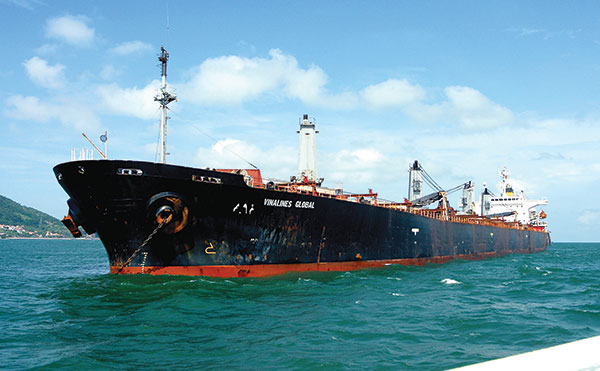Vinalines’ port activity surges
 |
| After years of stagnation, Vinalines joint-venture ports have growth spurts Photo: Le Toan |
According to a VIR source, SP-PSA, a joint-venture port of Vinalines and Singapore-based PSA, saw its volume of bulk goods increase 32.7 per cent on-year to 1.54 million tonnes last year. Container throughput reached 67 twenty-foot equivalent units (TEUs).
The port located in the Cai Mep-Thi Vai area of the southern province of Ba Ria-Vung Tau made revenue of $3.07 million in the year, up 33.47 per cent on-year.
SSIT, a joint venture between Vinalines and US-based Carrix/SSA, handled 3.8 million tonnes of goods during the period, doubling its 2015 volume. The port, also in Cai Mep-Thi Vai, reported revenue of over $5 million, up 85 per cent on-year.
2016 also saw business improvements at Cai Lan International Container Terminal (CICT), located in the northern province of Quang Ninh. This joint venture also has Carrix/SSA as a partner.
CICT accommodated over 3.82 million tonnes goods in bulk last year, up 38.9 per cent, while revenue rose 22.6 per cent to over $8 million.
The year was also a success for Cai Mep International Terminal (CMIT), the joint venture between Vinalines and Danish company APM Terminals, the world’s leading port operator with 72 container terminals in 69 countries.
In 2015, the volume of container throughput goods shipped via CMIT rose 80 per cent on-year to over 720,000 TEUs. The figure reached over 1.2 million TEUs by the end of 2016, after years of clocking just 31.7 per cent of capacity. This port’s revenue also rose 28.2 per cent to $22.4 million.
Good performance by the foreign joint-venture ports has contributed to a significant on-year rise of 36 per cent in the total volume of container throughput of ports in the Cai Mep-Thi Vai area in 2016, to around three million TEUs out of an annual designed capacity of over seven million TEUs.
“The significant rise in the volume of goods in bulk at CICT, SSIT, and SP-PSA was attributed to strong demands for imported animal feed, soy beans, and corn in 2016 – which are the ports’ key items,” Nguyen Canh Tinh, acting CEO of Vinalines, told VIR.
“In addition, a solid rise in the country’s container volume and more goods flows from Saigon port to Cai Mep-Thi Vai has contributed to CMIT’s robust growth of container throughput,” he added. “The seaport sector is likely to grow 10-12 per cent this year.”
After years of difficulties in attracting cargo, the Cai Mep-Thi Vai port complex are pushing to become important transhipment hubs as well as gateways to the south.
Last week marked an important milestone for CMIT and the Cai Mep-Thi Vai port complex, as it successfully launched a trial berth for 18,000 TEU vessels. The port of call of “Margrethe Maersk” is the first call ever of a Maersk Line Triple-E container vessel to Vietnam – the largest container vessel ever to come to Vietnam.
“This important ‘test call’ confirms our strong commitment to Vietnam – a commitment that had its start almost a century ago, when the first Maersk vessel arrived in Vietnam in 1923. Last year we started direct service between Vietnam and North America. With the ‘test call’ we hope we are on the way to establishing a direct service between Vietnam and Europe,” said an official on the Margrethe Maersk.
Currently, the Cai Mep-Thi Vai port complex accommodates 10 direct services to the US weekly. For imports and exports from and to the European market, there are three weekly mainline services connecting directly with Europe. Terminals in Cai Mep-Thi Vai also berth seven services dedicated to intra-Asia imports and exports.
What the stars mean:
★ Poor ★ ★ Promising ★★★ Good ★★★★ Very good ★★★★★ Exceptional
Latest News
More News
- Ericsson a trusted partner in the digital economy (December 03, 2025 | 10:33)
- 5G and AI to shape next phase of digital economy (December 03, 2025 | 10:25)
- Fly to Con Dao from 0 VND with Vietjet mega promotion (December 02, 2025 | 16:50)
- Tien Phong strives for a greener plastics industry (December 02, 2025 | 09:22)
- Czech enterprises strengthen presence (December 01, 2025 | 18:00)
- New phase launched to support women-led ventures (December 01, 2025 | 15:08)
- Airlines race to patch Airbus A320/A321 fleets (December 01, 2025 | 09:17)
- European expertise to boost Vietnam’s sustainable logistics push (November 29, 2025 | 10:00)
- AkzoNobel: from painting walls to painting the future (November 28, 2025 | 13:31)
- Tien Phong Plastic ready for a new growth cycle (November 28, 2025 | 10:56)
















 Mobile Version
Mobile Version